The unmistakable aroma of adobo always meant comfort and family gatherings. This Chicken and Pork Adobo recipe isn't just another variation, it's the exact way my grandmother taught me to make her signature dish, combining the tender succulence of both pork and chicken in one irresistible pot.
Every time I make this adobo, the rich garlic-infused sauce simmering on my stove brings me right back to Sunday lunches with my family, where we'd fight over the last pieces of meat and the coveted sauce to drizzle over our steaming white rice.
This foolproof chicken and pork adobo recipe will guide you to create that perfect balance of salty, tangy, and savory flavors that makes Filipino adobo absolutely unforgettable.
Jump to:
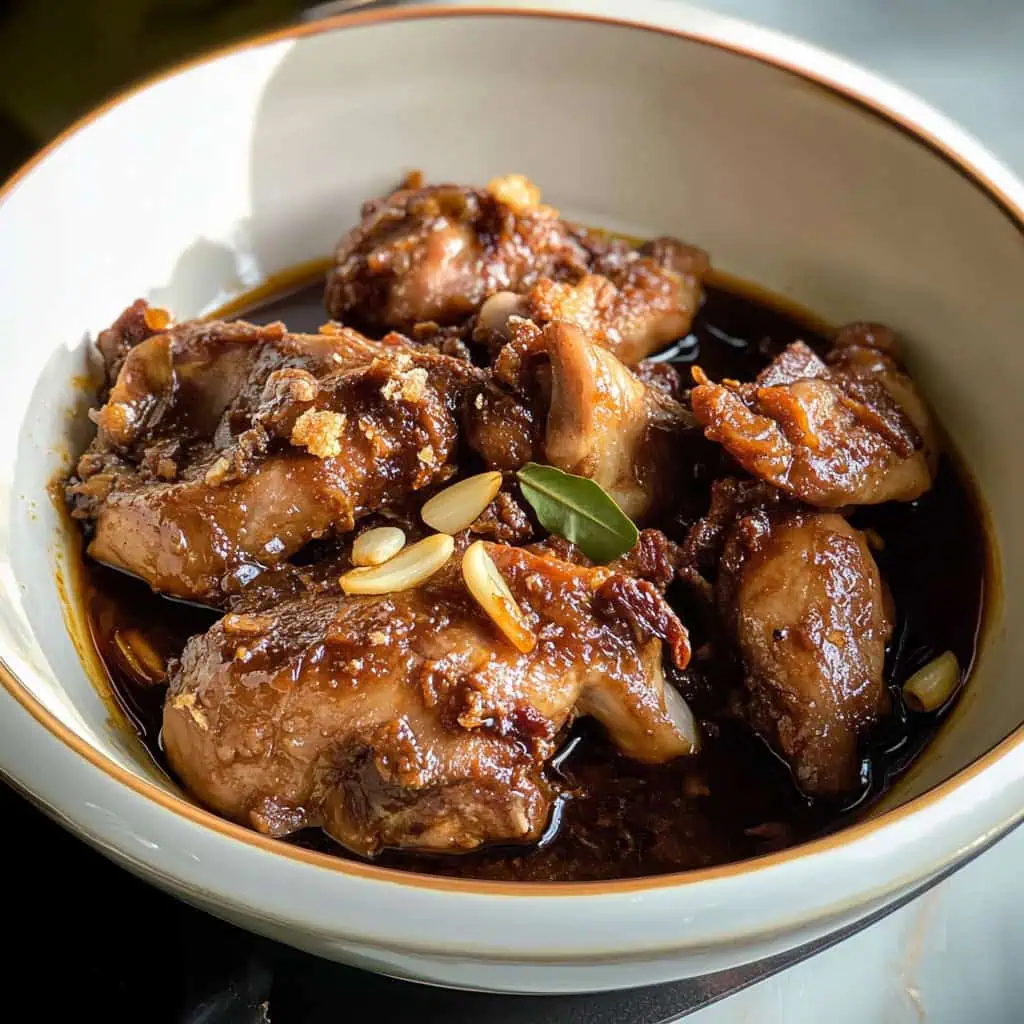
Why You'll Love This Recipe
- Perfect Balance: The harmonious blend of soy sauce (toyo) and vinegar (suka) creates an addictive umami-rich sauce
- Make-Ahead Friendly: Tastes even better the next day as flavors continue to develop
- Budget-Friendly: Uses affordable cuts of meat and pantry staples
- One-Pot Wonder: Minimal cleanup required
- Versatile: Can be served for everyday meals or special occasions
- Authentic Taste: Features the traditional Filipino cooking method passed down through generations
- Freezer-Friendly: Perfect for meal prep and batch cooking
Ingredients
Every component in this recipe serves a purpose: the combination of pork and chicken creates a perfect balance of rich and lean proteins; vinegar tenderizes the meat while providing tang; soy sauce adds deep umami flavor; fresh garlic and onion form the aromatic base; bay leaves and peppercorns infuse subtle complexity.
And the optional add-ins allow for customization: potatoes absorb excess saltiness, eggs add richness, and brown sugar rounds out the flavors.
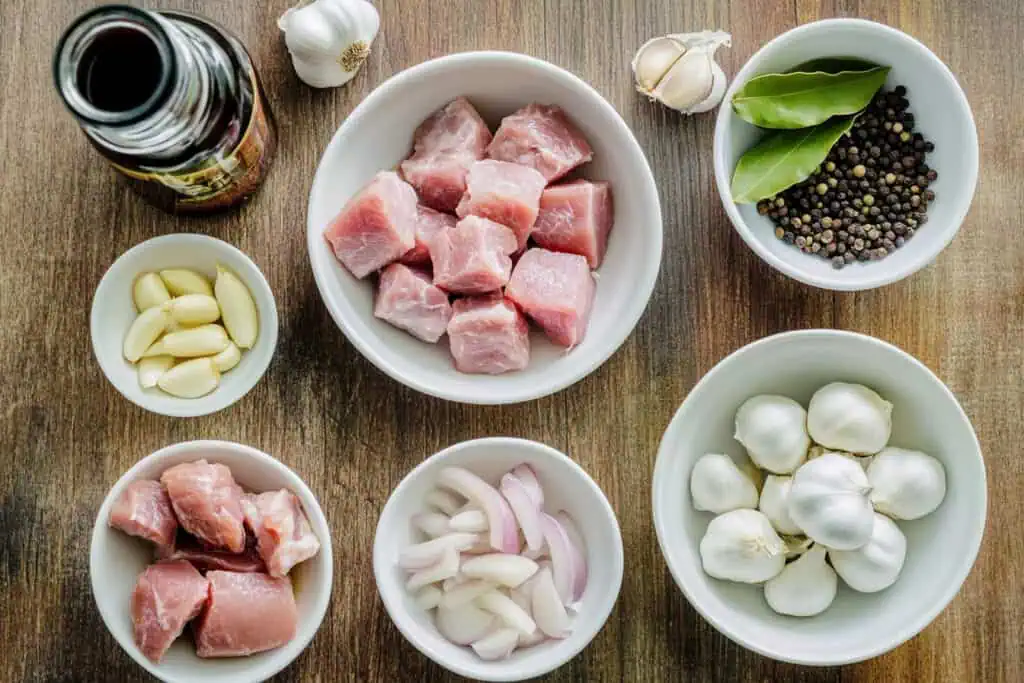
For the Main Dish:
- 1½ pounds pork shoulder or belly, cut into 2-inch cubes
- 1½ pounds chicken parts, preferably bone-in
- 1 cup white vinegar
- ½ cup soy sauce
- 1 whole head garlic, minced
- 1 large onion, sliced thinly
- 2 bay leaves
- 1 tablespoon whole black peppercorns
- 1 cup water
- 1 tablespoon cooking oil
- Salt to taste
Optional Add-ins:
- 2-3 medium potatoes, quartered
- 4-6 hard-boiled eggs
- 2 teaspoons brown sugar
Equipment
- Large heavy-bottom pot or Dutch oven: For even heat distribution and preventing burning of the sauce
- Sharp knife: For cutting meat into uniform pieces to ensure even cooking
- Wooden spoon: For stirring without scratching the pot and maintaining its longevity
- Measuring cups and spoons: For precise ingredient portions to achieve the perfect flavor balance
- Tongs: For easy meat handling during browning and serving
- Kitchen thermometer: For checking meat doneness (chicken should reach 165°F, pork 145°F)
- Garlic press (optional): For efficiently mincing fresh garlic to release maximum flavor
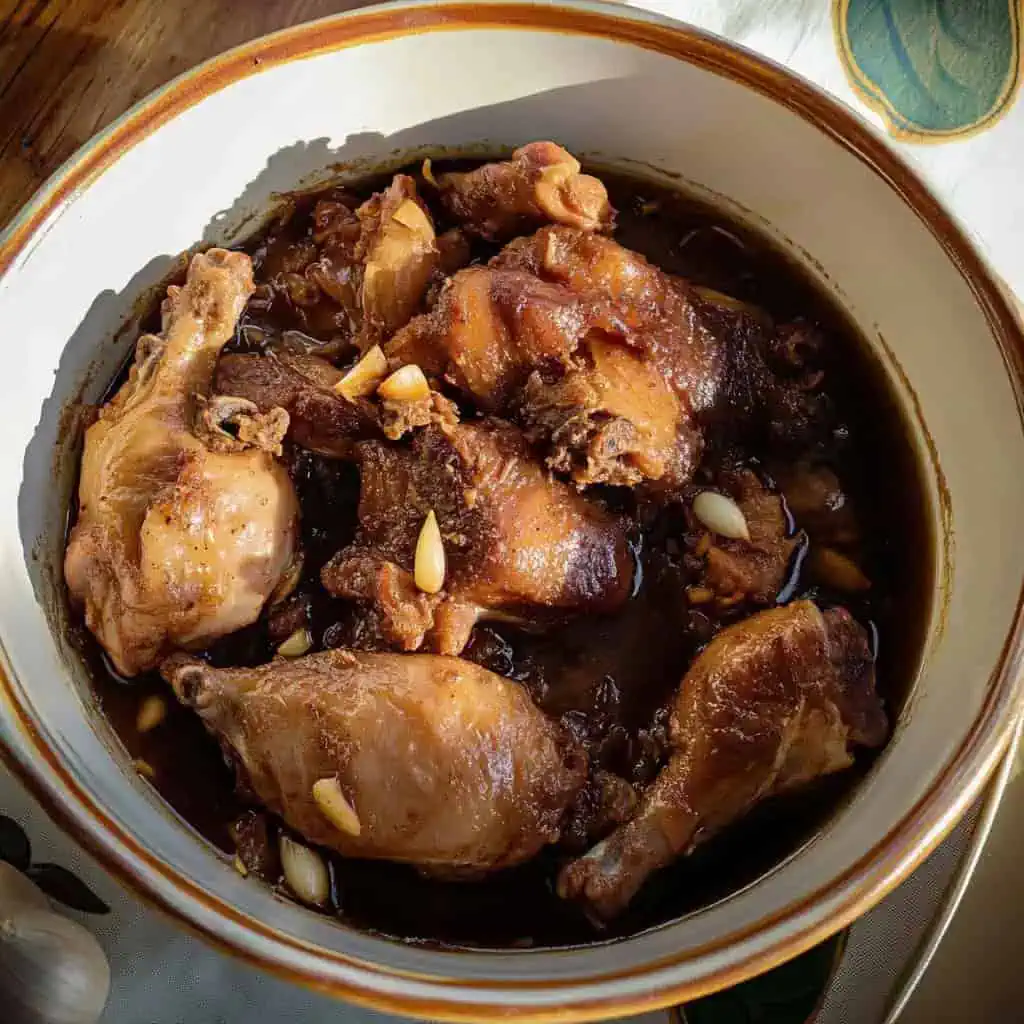
How To Make
- Pat dry your chicken pieces and pork belly cubes with paper towels. Season them well with salt and black pepper on all sides.
- Heat your large pot or pan over medium heat. Add oil and let it get hot. Once hot, add your sliced onions and cook them until they turn clear and soft, about 3 minutes. Add all the minced garlic and cook for 1 minute until fragrant.
- Add the pork belly pieces first. Cook them for about 7-10 minutes, turning them occasionally until they're lightly browned on all sides. Now add your chicken pieces and cook for another 5-7 minutes until they also start to brown.
- Pour in the vinegar and let it come to a boil. Important tip: don't stir for the first 3-5 minutes after adding the vinegar. This helps make the vinegar taste less sharp. After this, add the soy sauce, whole peppercorns, bay leaves, and water.
- Let everything come to a boil, then lower the heat. Cover your pot and let it simmer gently for about 30-40 minutes. Stir occasionally to make sure nothing sticks to the bottom. You'll know it's done when both the chicken and pork are tender enough to easily pierce with a fork, and the sauce has thickened slightly.
- Turn off the heat and let your adobo rest for about 10 minutes. This helps all the flavors meld better. Taste the sauce and add more salt or pepper if needed.
- Serve your adobo hot over freshly cooked white rice. The sauce is perfect for drizzling over your rice.

Tips from Lola's Kitchen
- Choose vinegar wisely: Cane vinegar is traditional, but white vinegar works well too. Each type of vinegar contributes a unique flavor profile to your adobo.
- Don't skip the browning: Properly browning the meat develops deeper, more complex flavors in the finished dish.
- Use "Adobo Cut" chicken: Chicken pieces should be slightly larger than bite-sized to prevent them from disintegrating during the long cooking process.
- Patience pays off: Allow the meats to simmer slowly until truly tender. Rushing this step will result in tough meat.
- Let it rest: Adobo tastes even better after the flavors have had time to meld. If possible, make it a few hours ahead or even the day before serving.
- Save the sauce: Leftover adobo sauce makes an excellent flavor base for fried rice, soups, or other meat dishes.
- Cook in layers: Adding pork first and then chicken ensures each meat is perfectly cooked without any becoming too soft.
- Balance is key: Adjust the vinegar and soy sauce ratio to your family's preference. Some regions prefer a more tangy adobo, while others like it more savory.
Substitutions
- Vinegar alternatives: Apple cider vinegar or coconut vinegar can replace white vinegar, each bringing a slightly different flavor profile.
- Soy sauce alternatives: Liquid aminos or coconut aminos work well for a gluten-free version, though the taste will be slightly milder.
- Meat options: You can make an all-chicken or all-pork version if preferred. For chicken-only, bone-in thighs work best. For pork-only, shoulder or belly provides the ideal fat content.
- Leaner choices: For a lighter version, use pork loin instead of belly and skinless chicken pieces, though the sauce won't be as rich.
- Garlic options: Jarred minced garlic can work in a pinch, but fresh provides the best flavor. Use 2 tablespoons pre-minced garlic to replace 1 whole head.
- Sweetener options: Palm sugar or honey can replace brown sugar for a different dimension of sweetness.
Troubleshooting
Too Salty:
- Add quartered potatoes to absorb excess salt
- Balance with a splash of additional vinegar or water
- Add a small amount of sugar to counteract saltiness
Too Sour:
- Add a pinch more sugar or a bit of honey
- Cook longer to mellow the vinegar's acidity
- Add a small additional splash of soy sauce to balance
Meat Too Tough:
- Continue simmering on low heat until fork-tender
- Add water if needed to prevent drying out
- Next time, cut meat into smaller, more uniform pieces
Sauce Too Thin:
- Simmer uncovered for 10-15 minutes to reduce
- Mix 1 teaspoon cornstarch with 1 tablespoon cold water and stir in
- Remove meat temporarily and reduce sauce separately
Sauce Too Thick:
- Add small amounts of water or chicken broth
- Add a splash more vinegar if it needs more tang
Storage & Reheating
Refrigerator storage:
- Store in an airtight container for 3-4 days
- The flavor actually improves after 24 hours as ingredients meld
Freezer storage:
- Freeze in portion-sized containers for up to 3 months
- Label with date and contents
- Leave some space for expansion
Proper reheating temperature:
- Ensure internal temperature reaches 165°F (74°C) for food safety
Microwave reheating:
- Heat in 2-3 minute intervals on medium power
- Stir between intervals for even heating
- Cover with a microwave-safe lid to prevent splattering
Stovetop reheating:
- Use low heat with a splash of water to prevent burning
- Stir occasionally until thoroughly heated
- This method better preserves the texture of the meat
Serving after storage:
- Garnish with fresh elements like sliced green onions to brighten the dish
- A squeeze of fresh calamansi or lemon juice can revive flavors
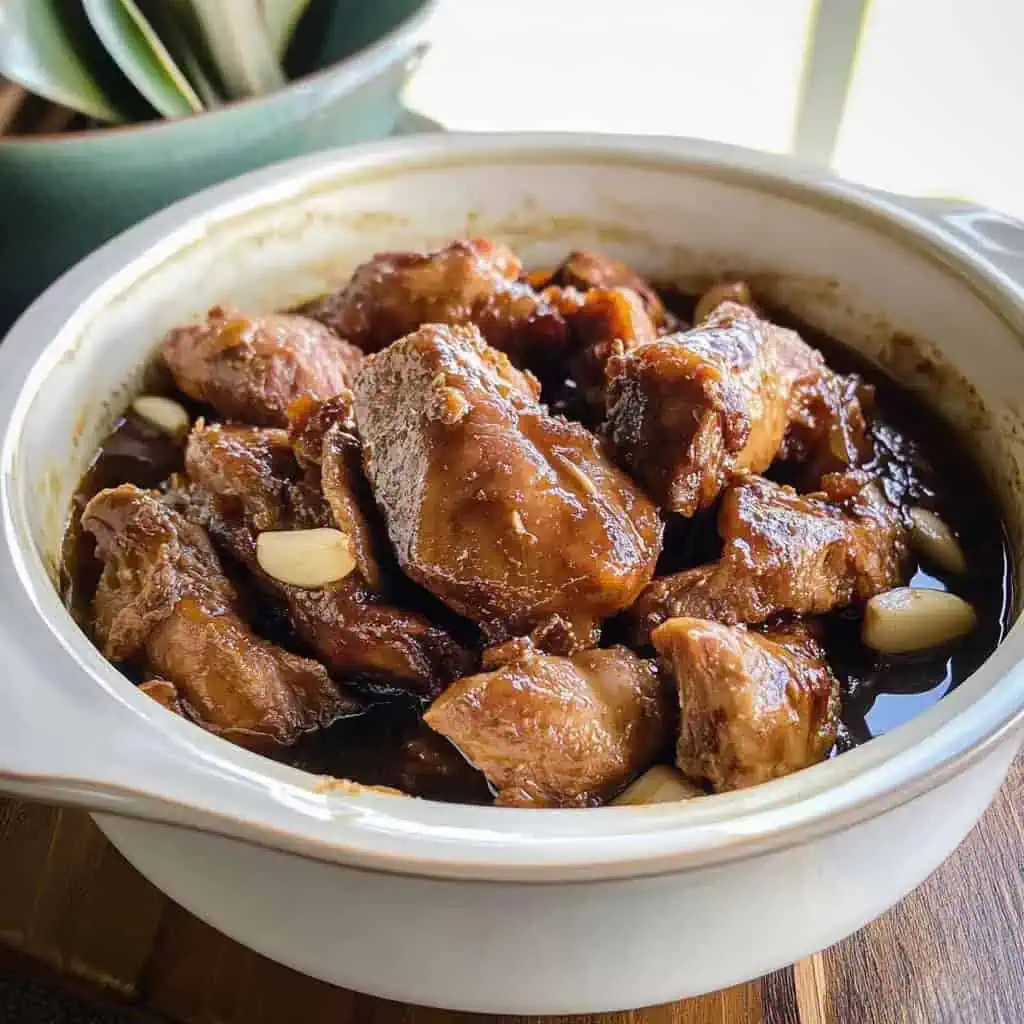
FAQ
Why should I not stir after adding vinegar?
This allows the vinegar to cook off its harsh acidic taste naturally without disrupting the process. Stirring too early can trap the harsh notes in the dish.
Can I marinate the meat overnight?
Yes, marinating enhances flavor development, though it isn't necessary for a delicious adobo. If marinating, reduce the cooking time slightly as the meat will already be infused with flavor.
Why is my sauce not thickening?
Try simmering uncovered for the last 10-15 minutes to reduce the sauce. The natural fats from the meat should also help thicken it as they render during cooking.
How do I know when my adobo is perfectly done?
The meat should be fork-tender (easily pierced), chicken should reach an internal temperature of 165°F, and pork should reach 145°F. The sauce should coat the back of a spoon nicely.
Can I make this in a slow cooker or pressure cooker?
Yes! For slow cooker: brown meat first, then cook on low for 6-8 hours. For pressure cooker/Instant Pot: brown meat using sauté function, then pressure cook for 15 minutes with natural release.
Is adobo better the next day?
Many Filipinos believe adobo tastes best the day after cooking, as the flavors have more time to develop and meld together. This makes it perfect for meal prep!
Can I use boneless meat instead?
Yes, though bone-in pieces add more flavor. If using boneless, reduce cooking time by 5-10 minutes and check for doneness earlier.
How can I make my adobo look glossier?
A teaspoon of honey or brown sugar added near the end of cooking can give your adobo that attractive glaze while adding subtle sweetness.
Can I add vegetables to my adobo?
Absolutely! Potatoes, carrots, bell peppers, and even green beans are delicious additions. Add firmer vegetables like potatoes and carrots halfway through cooking, and more delicate vegetables in the last 10 minutes.
Related
Looking for other recipes like this? Try these:
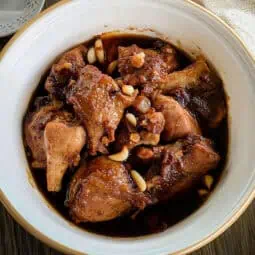
Filipino Chicken and Pork Adobo (Adobong Manok at Baboy)
Equipment
- Large heavy-bottom pot or Dutch oven (kaldero) For even heat distribution and preventing burning
- Sharp knife (kutsilyo) For cutting meat into uniform pieces
- Wooden spoon (sandok) For stirring without scratching the pot
- Measuring cups and spoons (Panukat) For precise ingredient portions
- Tongs For easy meat handling
- Kitchen thermometer For checking meat doneness
- Garlic press (optional) For mincing garlic efficiently
Ingredients
For the Main Dish:
- 1½ pounds pork shoulder or belly liempo, cut into 2-inch cubes
- 1½ pounds chicken parts manok, preferably bone-in
- 1 cup white vinegar suka
- ½ cup soy sauce toyo
- 1 whole head garlic bawang, minced
- 1 large onion sibuyas, sliced thinly
- 2 bay leaves dahon ng laurel
- 1 tablespoon whole black peppercorns paminta
- 1 cup water tubig
- 1 tablespoon cooking oil
- Salt asin to taste
Optional Add-ins:
- 2-3 medium potatoes patatas, quartered
- 4-6 hard-boiled eggs itlog
- 2 teaspoons brown sugar asukal na pula
Instructions
- First, pat dry your chicken pieces and pork belly cubes with paper towels. Season them well with salt and black pepper on all sides.
- Heat your large pot or pan over medium heat. Add oil and let it get hot. Once hot, add your sliced onions and cook them until they turn clear and soft, about 3 minutes. Add all the minced garlic and cook for 1 minute until you can smell its wonderful aroma.
- Add the pork belly pieces first. Cook them for about 7-10 minutes, turning them occasionally until they're lightly browned on all sides. Now add your chicken pieces and cook for another 5-7 minutes until they also start to brown.
- Pour in the vinegar and let it come to a boil. Here's an important tip - don't stir for the first 3-5 minutes after adding the vinegar. This helps make the vinegar taste less sharp. After this, add the soy sauce, whole peppercorns, bay leaves, and water.
- Let everything come to a boil, then lower the heat. Cover your pot and let it simmer gently for about 30-40 minutes. Stir occasionally to make sure nothing sticks to the bottom. You'll know it's done when both the chicken and pork are tender enough to easily pierce with a fork, and the sauce has thickened slightly.
- Turn off the heat and let your adobo rest for about 10 minutes. This helps all the flavors come together better. Taste the sauce and add more salt or pepper if needed. Serve your adobo hot over freshly cooked white rice. The sauce is perfect for drizzling over your rice.
- For leftovers, let the adobo cool completely before storing it in an airtight container in the refrigerator. It actually tastes even better the next day, and you can keep it for up to 3 days.
Tips from Lola's Kitchen
- Choose vinegar wisely: Cane vinegar (sukang maasim) is traditional, but white vinegar works well
- Don't skip the browning: It develops deeper flavors
- "Adobo Cut" chicken pieces should be slightly larger than bite-sized
- Let it rest: Adobo tastes better after flavors meld for a few hours
- Save the sauce: Leftover sauce makes an excellent flavor base for other dishes
Nutrition
The Story Behind Chicken and Pork Adobo
Before Spanish colonizers arrived in the Philippines, our ancestors were already practicing the art of preservation through vinegar and salt – a cooking method that would later evolve into what we now know as adobo. Unlike its Spanish namesake, Filipino adobo was born from our tropical climate's necessity, where food needed to be preserved in the humid environment of our 7,641 islands.
The addition of soy sauce to traditional adobo came much later, through Chinese traders who frequently visited our shores. This fusion created the darker, more umami-rich version that most Filipinos love today. While every region has its own take on adobo – from the coconut milk-based adobo sa gata in Bicol to the turmeric-tinged yellow adobo in Cavite – the combination of chicken and pork in one dish represents Filipino ingenuity and practicality. Known affectionately as "CPA" (Chicken Pork Adobo) in many households, this two-meat version maximizes flavor while ensuring nothing goes to waste.
What makes this dish truly special is its role in Filipino culture. It's often called our unofficial national dish, and for good reason. Whether you're in a humble carinderia in Tondo or a high-end restaurant in Makati, adobo remains a testament to Filipino resourcefulness and creativity. The dish even varies from family to family – some add potatoes, others swear by liver spread, while certain households insist on an extra splash of vinegar. These variations aren't just recipes; they're stories of Filipino families passed down through generations.
Today's version of Chicken and Pork Adobo combines the best of both worlds – the rich, fatty goodness of pork belly with the leaner, more delicate chicken pieces. The meat slowly braises in the classic combination of vinegar, soy sauce, garlic, and bay leaves until it reaches that perfect state where it's tender enough to pull apart with a fork, yet still holds its shape. The sauce, dark and glistening, becomes a perfect harmony of salty, tangy, and savory flavors that Filipinos around the world recognize as the taste of home.
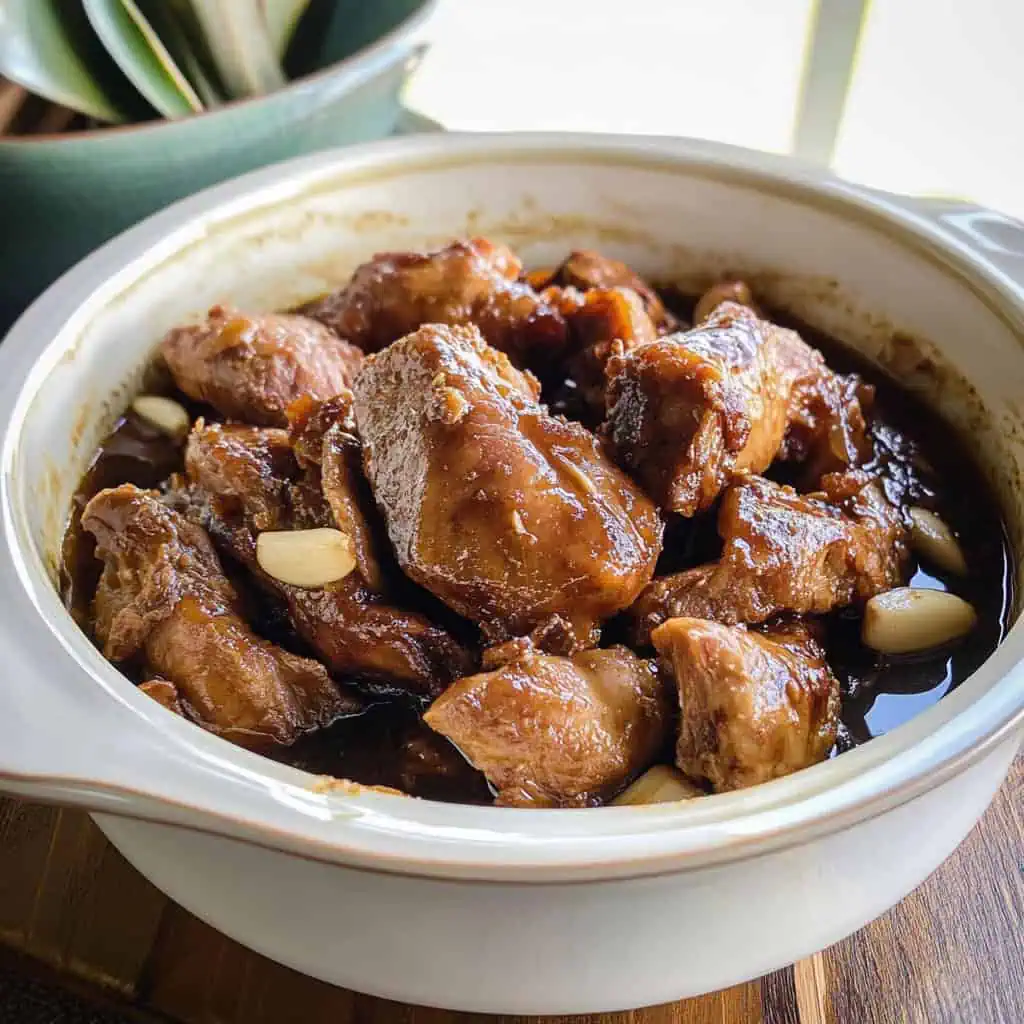









Comments
No Comments